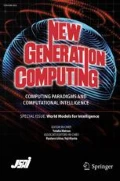Abstract
To provide robots with the flexibility they need to cope with various environments, motion generation techniques using deep learning have been proposed. Generalization in deep learning is expected to enable flexible processing in unknown situations and flexible motion generation. Motion generation models have been proposed to realize specific robot tasks, and their operation successes in unknown situations have been reported. However, their generalization performances have not been analyzed or verified in detail. In this paper, we analyze the internal state of a deep neural network using principal component analysis and verify the generalization of motion against environmental change, specifically a repositioned door knob. The results revealed that the motion primitives were structured in accordance with the position of the door knob. In addition, motion with high generalization performance was obtained by adaptive transition of motion primitives in accordance with changes in the door knob position. The robot was able to successfully perform a door-open-close task at various door knob positions.










Similar content being viewed by others
References
Levine, S., et al.: Learning hand-eye coordination for robotic grasping with deep learning and large-scale data collection. Int. J. Robot. Res. 37(4–5), 421–436 (2018)
Kase, K., et al.: Put-in-box task generated from multiple discrete tasks by a Humanoid robot using deep learning. In: 2018 IEEE International Conference on Robotics and Automation (ICRA). IEEE, (2018)
Le, Q.V., et al.: Building high-level features using large scale unsupervised learning (2011). arXiv:1112.6209
Krizhevsky, A., Sutskever, I., Hinton, G.E.: Imagenet classification with deep convolutional neural networks. In: Advances in Neural Information Processing Systems (2012)
Vinyals, Le, Q.O.: A neural conversational model (2015). arXiv:1506.05869
Szegedy, C., et al.: Going deeper with convolutions. In: Proceedings of the IEEE Conference on Computer Vision and Pattern Recognition. (2015)
Levine, S., et al.: End-to-end training of deep visuomotor policies. J. Mach. Learn. Res. 17(1), 1334–1373 (2016)
Inoue, T., et al.: Deep reinforcement learning for high precision assembly tasks. In: 2017 IEEE/RSJ International Conference on Intelligent Robots and Systems (IROS). IEEE, (2017)
Yahya, A., et al.: Collective robot reinforcement learning with distributed asynchronous guided policy search. In: 2017 IEEE/RSJ International Conference on Intelligent Robots and Systems (IROS). IEEE, (2017)
Gu, S., et al.: Deep reinforcement learning for robotic manipulation with asynchronous off-policy updates. In: 2017 IEEE International Conference on Robotics and Automation (ICRA). IEEE, (2017)
Noda, K., et al.: Multimodal integration learning of robot behavior using deep neural networks. Robot. Auton. Syst. 62(6), 721–736 (2014)
Yang, P.-C., et al.: Repeatable folding task by humanoid robot worker using deep learning. IEEE Robot. Autom. Lett. 2(2), 397–403 (2017)
Xu, K., et al.: Show, attend and tell: neural image caption generation with visual attention. In: International Conference on Machine Learning. (2015)
Smilkov, D., et al.: Smoothgrad: removing noise by adding noise (2017). arXiv:1706.03825
Hinton, G.E., Salakhutdinov, R.R.: Reducing the dimensionality of data with neural networks. Science 313(5786), 504–507 (2006)
Masci, J., et al.: Stacked convolutional auto-encoders for hierarchical feature extraction. In: International Conference on Artificial Neural Networks. Springer, Berlin, Heidelberg (2011)
Sabour, S., Frosst, N., Hinton, G.E.: Dynamic routing between capsules. In: Advances in Neural Information Processing Systems (2017)
Namikawa, J., Nishimoto, R., Tani, J.: A neurodynamic account of spontaneous behaviour. PLoS Comput. Biol. 7(10), e1002221 (2011)
Kingma, D.P., Ba, J.: Adam: a method for stochastic optimization (2014). arXiv:1412.6980
Yamashita, Y., Tani, J.: Emergence of functional hierarchy in a multiple timescale neural network model: a humanoid robot experiment. PLoS Comput. Biol. 4(11), e1000220 (2008)
Werbos, P.J.: Backpropagation through time: what it does and how to do it. Proc. IEEE 78(10), 1550–1560 (1990)
Hochreiter, S., Schmidhuber, J.: Long short-term memory. Neural Comput. 9(8), 1735–1780 (1997)
Author information
Authors and Affiliations
Corresponding author
Additional information
Publisher's Note
Springer Nature remains neutral with regard to jurisdictional claims in published maps and institutional affiliations.
About this article
Cite this article
Ito, H., Yamamoto, K., Mori, H. et al. Evaluation of Generalization Performance of Visuo-Motor Learning by Analyzing Internal State Structured from Robot Motion. New Gener. Comput. 38, 7–22 (2020). https://doi.org/10.1007/s00354-019-00083-x
Received:
Accepted:
Published:
Issue Date:
DOI: https://doi.org/10.1007/s00354-019-00083-x




